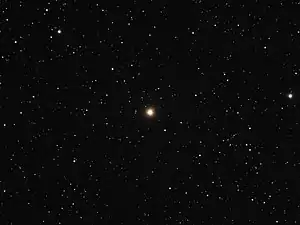11 Lacertae
11 Lacertae is a star in the northern constellation of Lacerta. It is visible to the naked eye as a faint orange-hued star with an apparent visual magnitude of 4.46.[3] It lies at a distance of about 333[2] light years and has an absolute magnitude -0.54.[6] The object is moving closer to the Earth with a heliocentric radial velocity of −10.9 km/s.[5]
 11 Lacertae in optical light | |
| Observation data Epoch J2000 Equinox J2000 | |
|---|---|
| Constellation | Lacerta[1] |
| Right ascension | 22h 40m 30.85881s[2] |
| Declination | +44° 16′ 34.7042″[2] |
| Apparent magnitude (V) | 4.46[3] |
| Characteristics | |
| Spectral type | K2.5 III[4] |
| U−B color index | +1.36[3] |
| B−V color index | +1.33[3] |
| Astrometry | |
| Radial velocity (Rv) | −10.91±0.09[5] km/s |
| Proper motion (μ) | RA: +94.426[2] mas/yr Dec.: +11.606[2] mas/yr |
| Parallax (π) | 9.80 ± 0.26[2] mas |
| Distance | 333 ± 9 ly (102 ± 3 pc) |
| Absolute magnitude (MV) | −0.54[6] |
| Details[7] | |
| Mass | 1.38 M☉ |
| Radius | 27.70 R☉ |
| Luminosity | 204 L☉ |
| Surface gravity (log g) | 1.93[8] cgs |
| Temperature | 4,352[8] K |
| Metallicity [Fe/H] | −0.19[8] dex |
| Rotational velocity (v sin i) | 8[9] km/s |
| Age | 3.2 Gyr |
| Other designations | |
| Database references | |
| SIMBAD | data |
This is an evolved giant star with a stellar classification of K2.5 III.[4] It is a red clump giant, meaning it is fusing helium in its core after passing through the red giant branch.[7] The star is 3.2 billion years old with 1.38 times the mass of the Sun and has expanded to 27.7 times the Sun's radius.[7] It is radiating 204[7] times the Sun's luminosity from its enlarged photosphere at an effective temperature of 4,352 K.[8]
References
- Roman, N. G. (1987). "Identification of a Constellation from a Position". Retrieved 2006-12-26.
- Van Leeuwen, F. (2007). "Validation of the new Hipparcos reduction". Astronomy and Astrophysics. 474 (2): 653–664. arXiv:0708.1752. Bibcode:2007A&A...474..653V. doi:10.1051/0004-6361:20078357. S2CID 18759600.
- Ducati, J. R. (2002). "VizieR Online Data Catalog: Catalogue of Stellar Photometry in Johnson's 11-color system". CDS/ADC Collection of Electronic Catalogues. 2237. Bibcode:2002yCat.2237....0D.
- Keenan, Philip C.; McNeil, Raymond C. (1989). "The Perkins catalog of revised MK types for the cooler stars". Astrophysical Journal Supplement Series. 71: 245. Bibcode:1989ApJS...71..245K. doi:10.1086/191373.
- Famaey, B.; et al. (2005), "Local kinematics of K and M giants from CORAVEL/Hipparcos/Tycho-2 data. Revisiting the concept of superclusters", Astronomy and Astrophysics, 430: 165–186, arXiv:astro-ph/0409579, Bibcode:2005A&A...430..165F, doi:10.1051/0004-6361:20041272, S2CID 17804304.
- Anderson, E.; Francis, Ch.; Niedzielski, A. (2012). "XHIP: An extended hipparcos compilation". Astronomy Letters. 38 (5): 331. arXiv:1108.4971. Bibcode:2012AstL...38..331A. doi:10.1134/S1063773712050015. S2CID 119257644.
- Adamczyk, M.; Deka-Szymankiewicz, B.; Niedzielski, A. (2016). "Masses and luminosities for 342 stars from the PennState-Toruń Centre for Astronomy Planet Search". Astronomy and Astrophysics. 587: A119. arXiv:1510.07495. Bibcode:2016A&A...587A.119A. doi:10.1051/0004-6361/201526628. S2CID 119299522.
- Maldonado, J.; Villaver, E.; Niedzielski, A. (2016). "Evolved stars and the origin of abundance trends in planet hosts". Astronomy and Astrophysics. 588: A98. arXiv:1602.00835. Bibcode:2016A&A...588A..98M. doi:10.1051/0004-6361/201527883. S2CID 119212009.
- Bernacca, P. L.; Perinotto, M. (1970). "A catalogue of stellar rotational velocities". Contributi Osservatorio Astronomico di Padova in Asiago. 239 (1): 1. Bibcode:1970CoAsi.239....1B.
- "11 Lac". SIMBAD. Centre de données astronomiques de Strasbourg. Retrieved 2019-02-01.